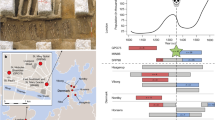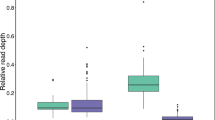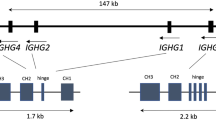Abstract
The evolutionary origin of genetic diversity in the SLAM/CD2 gene cluster, implicated in autoimmune lupus susceptibility in mice, was investigated by sequence analysis of exons from six members of the cluster in 48 wild mouse samples derived from the global mouse population. A total of 80 coding region SNPs were identified among the six genes analyzed, indicating that this gene cluster is highly polymorphic in natural mouse populations. Phylogenetic analyses of these allelic sequences revealed clustering of alleles derived from multiple Mus species and subspecies, indicating alleles at several SLAM/CD2 loci were present in ancestral Mus populations prior to speciation and have persisted as polymorphisms for more than 1 million years. Analyses of nonsynonymous/synonymous ratios using likelihood codon substitution models identified several segments in Cd229, Cd48 and Cd84 that were impacted by positive diversifying selective pressures. These findings support the interpretation that selection favoring the generation and retention of functional polymorphisms has played a role in the evolutionary origin of genetic polymorphisms that are predisposing to autoimmunity.
This is a preview of subscription content, access via your institution
Access options
Subscribe to this journal
Receive 6 digital issues and online access to articles
$119.00 per year
only $19.83 per issue
Buy this article
- Purchase on Springer Link
- Instant access to full article PDF
Prices may be subject to local taxes which are calculated during checkout




Similar content being viewed by others
References
Hughes AL, Nei M . Pattern of nucleotide substitution at major histocompatibility complex class I loci reveals overdominant selection. Nature 1988; 335: 167–170.
Hughes AL, Nei M . Nucleotide substitution at class II MHC loci: evidence for overdominant selection. Proc Natl Acad Sci USA 1989; 86: 958–962.
She JX, Boehme SA, Wang TW, Bonhomme F, Wakeland EK . Amplification of major histocompatibility complex class II gene diversity by intra-exonic recombination. Proc Natl Acad Sci USA 1991; 88: 453–457.
Klein J, Satta Y, O'HUigin C, Takahata N . The molecular descent of the major histocompatibility complex. Annu Rev Immunol 1993; 11: 269.
McConnell TJ, Talbot WS, McIndoe RA, Wakeland EK . The origin of MHC class II gene polymorphism within the genus Mus. Nature 1988; 332: 651–654.
Lawlor DA, Ward FE, Ennis PD, Jackson AP, Parham P . HLA-A and B polymorphisms predate the divergence of humans and chimpanzees. Nature 1988; 335: 268–271.
Figueroa F, Gunther E, Klein J . MHC polymorphism pre-dating speciation. Nature 1988; 335: 265–267.
Parham P . MHC class I molecules and kirs in human history, health and survival. Nat Rev Immunol 2005; 5: 201–214.
Wandstrat AE, Nguyen C, Limaye N, Chan AY, Subramanian S, Tian XH et al. Association of extensive polymorphisms in the SLAM/CD2 gene cluster with murine lupus. Immunity 2004; 21: 769–780.
Graham RR, Ortmann WA, Langefeld CD, Jawaheer D, Selby SA, Rodine PR et al. Visualizing human leukocyte antigen class II risk haplotypes in human systemic lupus erythematosus. Am J Hum Genet 2002; 71: 543–553.
Todd JA, Bell JI, McDevitt HO . HLA-DQ gene contributes to susceptibility and resistance to insulin-dependent diabetes mellitus. Nature 1987; 329: 599–604.
Nepom GT, Kwok WW . Molecular basis for HLA-DQ associations with IDDM. Diabetes 1998; 47: 1177–1184.
Raman K, Mohan C . Genetic underpinnings of autoimmunity—lessons from studies in arthritis, diabetes, lupus and multiple sclerosis. Curr Opin Immunol 2003; 15: 651–659.
Wandstrat A, Wakeland E . The genetics of complex autoimmune diseases: non-MHC susceptibility genes. Nat Immunol 2001; 2: 802–809.
Lundberg AS, McDevitt HO . Evolution of major histocompatibility complex class II allelic diversity: direct descent in mice and humans. Proc Natl Acad Sci USA 1992; 89: 6545–6549.
Hughes AL, Hughes MK, Howell CY, Nei M . Natural selection at the class II major histocompatibility complex loci of mammals. Philos Trans R Soc Lond B Biol Sci 1994; 346: 359–366.
Veillette A, Latour S . The SLAM family of immune-cell receptors. Curr Opin Immunol 2003; 15: 277–285.
Engel P, Eck MJ, Terhorst C . The SAP and SLAM families in immune responses and X-linked lymphoproliferative disease. Nat Rev Immunol 2003; 3: 813–821.
Morel L, Blenman KR, Croker BP, Wakeland EK . The major murine systemic lupus erythematosus susceptibility locus, Sle1, is a cluster of functionally related genes. Proc Natl Acad Sci USA 2001; 98: 1787–1792.
Kumar KR, Li L, Yan M, Bhaskarabhatla M, Mobley AB, Nguyen C et al. Regulation of B cell tolerance by the lupus susceptibility gene Ly108. Science 2006; 312: 1665–1669.
Nachman MW, Boyer SN, Searle JB, Aquadro CF . Mitochondrial DNA variation and the evolution of Robertsonian chromosomal races of house mice, Mus domesticus. Genetics 1994; 136: 1105–1120.
Guenet JL, Bonhomme F . Wild mice: an ever-increasing contribution to a popular mammalian model. Trends Genet 2003; 19: 24–31.
Boissinot S, Boursot P . Discordant phylogeographic patterns between the Y chromosome and mitochondrial DNA in the house mouse: selection on the Y chromosome? Genetics 1997; 146: 1019–1034.
Jansa SA, Weksler M . Phylogeny of muroid rodents: relationships within and among major lineages as determined by IRBP gene sequences. Mol Phylogenet Evol 2004; 31: 256–276.
Lundrigan BL, Jansa SA, Tucker PK . Phylogenetic relationships in the genus mus, based on paternally, maternally, and biparentally inherited characters. Syst Biol 2002; 51: 410–431.
Yang Z, Nielsen R, Goldman N, Pedersen AM . Codon-substitution models for heterogeneous selection pressure at amino acid sites. Genetics 2000; 155: 431–449.
Somoza C, Driscoll PC, Cyster JG, Williams AF . Mutational analysis of the CD2/CD58 interaction: the binding site for CD58 lies on one face of the first domain of human CD2. J Exp Med 1993; 178: 549–558.
Jining L, Makagiansar I, Yusuf-Makagiansar H, Chow VT, Siahaan TJ, Jois SD . Design, structure and biological activity of beta-turn peptides of CD2 protein for inhibition of T-cell adhesion. Eur J Biochem 2004; 271: 2873–2886.
Romero X, Zapater N, Calvo M, Kalko SG, de la Fuente MA, Tovar V et al. CD229 (Ly9) lymphocyte cell surface receptor interacts homophilically through its N-terminal domain and relocalizes to the immunological synapse. J Immunol 2005; 174: 7033–7042.
Ueda H, Howson JM, Esposito L, Heward J, Snook H, Chamberlain G et al. Association of the T-cell regulatory gene CTLA4 with susceptibility to autoimmune disease. Nature 2003; 423: 506–511.
Sidorenko SP, Clark EA . The dual-function CD150 receptor subfamily: the viral attraction. Nat Immunol 2003; 4: 19–24.
Howie D, Laroux FS, Morra M, Satoskar AR, Rosas LE, Faubion WA et al. Cutting edge: the SLAM family receptor Ly108 controls T cell and neutrophil functions. J Immunol 2005; 174: 5931–5935.
Wang N, Satoskar A, Faubion W, Howie D, Okamoto S, Feske S et al. The cell surface receptor SLAM controls T cell and macrophage functions. J Exp Med 2004; 199: 1255–1264.
Shlapatska LM, Mikhalap SV, Berdova AG, Zelensky OM, Yun TJ, Nichols KE et al. CD150 association with either the SH2-containing inositol phosphatase or the SH2-containing protein tyrosine phosphatase is regulated by the adaptor protein SH2D1A. J Immunol 2001; 166: 5480–5487.
Veillette A . SLAM family receptors regulate immunity with and without SAP-related adaptors. J Exp Med 2004; 199: 1175–1178.
Davidson D, Shi X, Zhang S, Wang H, Nemer M, Ono N et al. Genetic evidence linking SAP, the X-linked lymphoproliferative gene product, to Src-related kinase FynT in T(H)2 cytokine regulation. Immunity 2004; 21: 707–717.
Cannons JL, Yu LJ, Hill B, Mijares LA, Dombroski D, Nichols KE et al. SAP regulates T(H)2 differentiation and PKC-theta-mediated activation of NF-kappaB1. Immunity 2004; 21: 693–706.
Moon UY, Park SJ, Oh ST, Kim WU, Park SH, Lee SH et al. Patients with systemic lupus erythematosus have abnormally elevated Epstein–Barr virus load in blood. Arthritis Res Ther 2004; 6: R295–R302.
Kang I, Quan T, Nolasco H, Park SH, Hong MS, Crouch J et al. Defective control of latent Epstein–Barr virus infection in systemic lupus erythematosus. J Immunol 2004; 172: 1287–1294.
Croker BP, Gilkeson G, Morel L . Genetic interactions between susceptibility loci reveal epistatic pathogenic networks in murine lupus. Genes Immun 2003; 4: 575–585.
Huelsenbeck JP, Ronquist F, Nielsen R, Bollback JP . Bayesian inference of phylogeny and its impact on evolutionary biology. Science 2001; 294: 2310–2314.
Acknowledgements
Support for these studies was provided by grants from the National Institute of Allergy and Infectious Disease to EKW. NL and KB were supported by NIH training grant no. NIH T32 AI 005284. FB was supported by ISEM 2007-084.
Author information
Authors and Affiliations
Corresponding author
Additional information
Supplementary Information accompanies the paper on Genes and Immunity website (http://www.nature.com/gene)
Rights and permissions
About this article
Cite this article
Limaye, N., Belobrajdic, K., Wandstrat, A. et al. Prevalence and evolutionary origins of autoimmune susceptibility alleles in natural mouse populations. Genes Immun 9, 61–68 (2008). https://doi.org/10.1038/sj.gene.6364446
Received:
Accepted:
Published:
Issue Date:
DOI: https://doi.org/10.1038/sj.gene.6364446
Keywords
This article is cited by
-
Dysregulated Lymphoid Cell Populations in Mouse Models of Systemic Lupus Erythematosus
Clinical Reviews in Allergy & Immunology (2017)
-
Is there sex-biased resistance and tolerance in Mediterranean wood mouse (Apodemus sylvaticus) populations facing multiple helminth infections?
Oecologia (2012)
-
Genetics of SLE: evidence from mouse models
Nature Reviews Rheumatology (2010)



